
[Alexandre Farto] is known for some off the wall art displays, but his newest work takes the phrase literally. Using precisely placed explosive charges, he has been sculpting portraits and other murals on walls in various places around London.
The detail at which he is able to produce these images is incredible, considering he is blowing chunks of plaster and brick from walls to form them. We can only guess as to how much preparation time is required to finish even one of these images, let alone to amass the stunning portfolio he has put together.
He has also recently teamed up with musical artist [Orelha Negra] to produce a cool video of his work as it was being sculpted, which is certainly worth the three minutes it takes to watch. The video, embedded below, is chock full of slow-motion shots of the demolition/sculpting in progress.
If you have a few minutes, be sure to check out his site to take a look at some of his work, we think you will be impressed.
Continue reading “Boom Goes The Dynamite – Murals Made With Precision Explosives”















